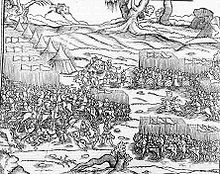Battle of Varna
His son-in-law and successor, King Albert, ruled for only two years and died in 1439, leaving his widow Elizabeth with an unborn child, Ladislaus the Posthumous.
The Hungarian noblemen then called the young King Władysław III of Poland to the throne of Hungary, expecting his aid in defense against the Ottomans.
After failed expeditions in 1440–1442 against Belgrade and Transylvania and the defeats of the Turks during Hunyadi's "long campaign" in 1442–1443, the Ottoman sultan Murad II signed a ten-year truce with Hungary.
Cesarini insisted that the Hungarian King Władysław III should break the treaty, arguing that it was not valid due to the fact that it had been made with infidels.
[16] Hungary co-operated with Venice and Pope Eugene IV to organize a new crusader army led by Hunyadi and Władysław III.
[19] The Hungarian advance was rapid, Ottoman fortresses were bypassed, while local Bulgarians from Vidin, Oryahovo, and Nicopolis joined the army (Fruzhin, son of Ivan Shishman, also participated in the campaign with his own guard).
At a supreme military council called by Hunyadi during the night, the papal legate, cardinal Julian Cesarini, insisted on a quick withdrawal.
However, the Christians were caught between the Black Sea, Lake Varna, the steep wooded slopes of the Franga Plateau (356 m high), and the enemy.
[21] In the morning of 10 November, Hunyadi deployed the army of some 20,000 crusaders as an arc between Lake Varna and the Franga plateau; the line was about 3.5 km long.
Behind the Hungarians, closer to the Black Sea and the lake, was the Wagenburg, defended by 300 or 600 Czech and Ruthenian mercenaries under hetman Ceyka, along with Poles, Lithuanians and Wallachians.
On his return, Hunyadi tried frantically to salvage the king's body, but all he could accomplish was to organize the retreat of the remains of his army; it suffered thousands of casualties in the chaos, and was virtually annihilated.
The minnesinger Michael Beheim wrote a song based on the story of Hans Mergest, who spent 16 years in Ottoman captivity after the battle.
Hunyadi reached the Danube but was captured by Vlad Dracul in Wallachia and imprisoned as insurance in case of Ottoman retaliation or for a high ransom.
He was released in exchange for a large amount of money when Hungarian nobles loyal to Hunyadi began to threaten Vlad Dracul with a campaign against him.
The Rise of the Ottomans bookmark of the grand strategy game Europa Universalis IV is intentionally set one day after the battle.



